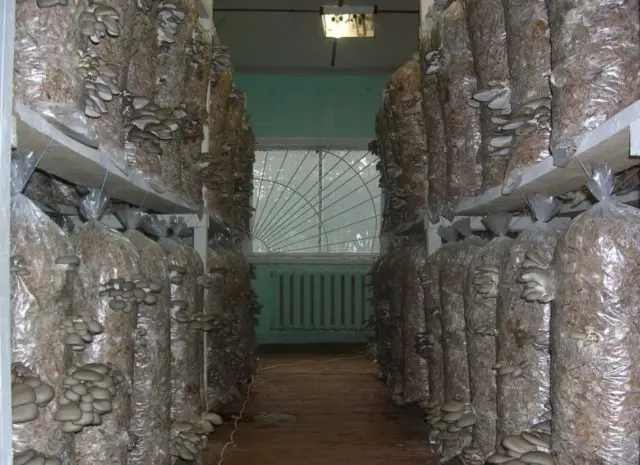Contents
The traditional cuisine of China and Japan is varied and amazing. Its distinctive feature is always that the food must be not only tasty, but also healthy. It was in these countries that the industrial cultivation of shiitake, an edible and healthy mushroom known for more than 2000 years, first began.
Is it possible to grow shiitake at home
Shiitake (shiitake), or imperial mushroom, grows in the wild in the territories of modern China and Japan. It was there that they first began to eat it, while noting not only its culinary value, but also its beneficial effect on health. Numerous studies of mycologists only confirmed the initial hypothesis.
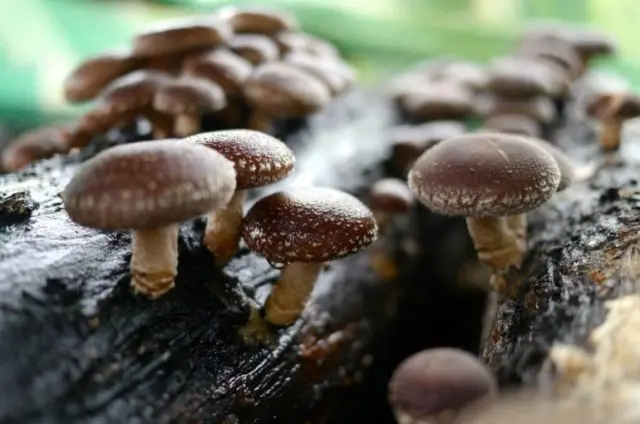
Shiitake is indeed a natural dietary supplement that has a lot of positive properties. Therefore, attempts to cultivate, i.e. to start growing this mushroom in artificial conditions, have been undertaken repeatedly. Over time, considerable experience was gained in the cultivation of shiitake, thanks to which this mushroom began to be cultivated in many countries. Now it is possible to do this even at home, but it will take a lot of effort and money.
Ways to grow shiitake mushrooms
Shiitake is a saprophytic fungus that parasitizes on decomposing plant debris. In nature, they grow on old stumps, rotten and dead wood. It is difficult to artificially create comfortable conditions for growing the emperor mushroom, since the shiitake mycelium ripens rather slowly, and besides, it is much inferior to other competitors in terms of endurance.
For cultivation of shiitake in artificial conditions, either an extensive or intensive method is used. The following describes the process of growing the emperor mushroom at home in both ways.
Growing shiitake on logs and stumps
The extensive method of cultivation is to create conditions for the growth of mushrooms, as close as possible to natural ones. This method is good only if the natural conditions correspond to the necessary ones. This concerns, first of all, the temperature and humidity of the environment. The method of growing shiitake on stumps and logs includes several stages:
- Procurement of suitable timber.
- Sterilization of logs.
- mycelial infection of wood.
- Further maintenance of the necessary conditions for the growth of fungi.
- Harvesting.
The extensive method of growing shiitake mushrooms on stumps takes a long time, but it is the one that produces the highest quality mushrooms. With this method of growth, fruiting bodies contain all the same components as when growing in the wild, therefore, they are as valuable as wild ones.

Growing shiitake on a substrate
The intensive method of cultivation consists in using as a nutrient medium for the development of mycelium not whole wood, but various plant residues. The composition of such a substrate for growing shiitake mushrooms includes straw, hardwood sawdust, wood chips, grain, bran, mineral additives.
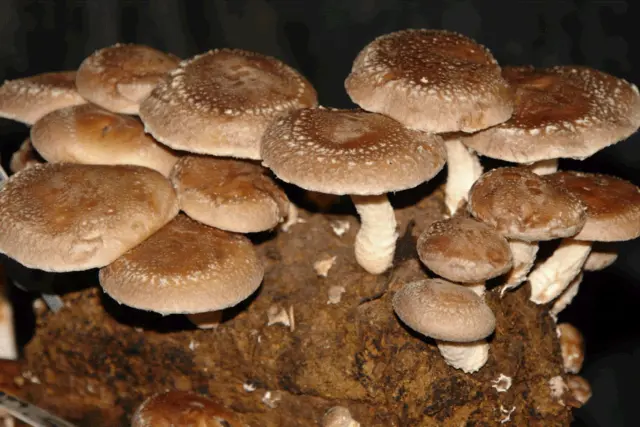
The components are mixed together in a certain proportion, then sterilized and infected with mycelium.
How to grow shiitake mushrooms
The process of growing shiitake mushrooms at home is long and difficult, but interesting and educational, especially for beginners. Before you do this, you should really assess your strengths and capabilities. Any room can be adapted for growing shiitake, if it is possible to provide the necessary microclimate parameters in it for a long time.
How to grow shiitake at home
Of course, growing shiitake in a city apartment is unlikely to succeed. However, in a private house, it is quite possible to allocate a separate part of the house for this purpose, for example, an isolated basement. In this room, it is necessary to provide for the possibility of regulating temperature, humidity and lighting. After preparing the site, you can begin to purchase the ingredients, necessary tools and materials.
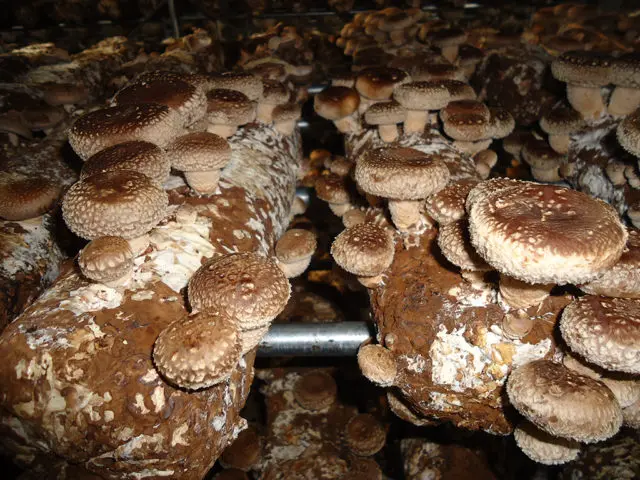
At home, it is better to use the intensive method of breeding shiitake mushrooms. To do this, you need to purchase the mycelium of the fungus. You can buy it either in specialized stores or on the Internet. Traditionally, shiitake mycelium is grown on a grain substrate or on sawdust. For home use, the first type is recommended; experts consider it to be the most suitable for growing the imperial mushroom at home.
The technology of growing shiitake mushrooms at home consists of the following steps:
- The choice of raw materials. Most often, cereals are used as the basis: rice, wheat, barley, rye. In favor of these components is their year-round availability, as well as relative purity. An important positive quality of grain mycelium is its rather long shelf life without loss of properties.
- Disinfect the carrier. Shiitake mycelium is very vulnerable. If other fungi or bacteria settle on the nutrient substrate, then it will die, unable to withstand competition. Therefore, the grain on which the mycelium is to develop is boiled or steamed for 20-30 minutes. Then the water is drained, and the grains are laid out in a thin layer to dry. You can remove excess moisture using chalk or gypsum, these materials are added to the grain in a ratio of 1:100.
- Block formation. Prepared grain is filled in sterilized glass jars with a capacity of 1-1,5 liters. About 1/3 of the volume on top should be left free, this will facilitate the work. From above, the jars are corked with cotton-gauze stoppers, and in their absence, with boiled nylon caps.
 Important! For growing mycelium, you can use special tight plastic bags with a zipper or with the ability to install a cotton-gauze filter.
Important! For growing mycelium, you can use special tight plastic bags with a zipper or with the ability to install a cotton-gauze filter. - Sterilization. Even after disinfection in boiling water, the grain may contain pathogens of fungal or bacterial diseases that can destroy shiitake mycelium in the future. To avoid an unfavorable development of the situation, the grain must be sterilized, that is, all the microflora contained in it must be killed. This is achieved by heating and keeping the substrate in an autoclave at a temperature of + 110-120 ° C and a pressure of 1,5-2 atmospheres. At home, it is unlikely that you will be able to use an autoclave, so the grain is often boiled over a fire using an ordinary iron barrel of 200 liters. If you keep the substrate in boiling water for 3-4 hours, then the result can be quite acceptable.
- Inoculation. At this stage, the so-called “seeding” of mushrooms is carried out, i.e., infection of the nutrient medium with shiitake mycelium. After cooling the substrate and keeping it for a certain time, a dry powder containing fungal spores is added to the container with a nutrient substrate. The process must be carried out very quickly in order to protect the containers with the substrate from foreign microflora entering them. After that, the containers are placed for incubation to form a full-fledged mycelium. At this time, the room maintains a temperature of about + 25 ° C and humidity of 60%.
 Important! All work must be carried out under sterile conditions using gloves.
Important! All work must be carried out under sterile conditions using gloves. - Incubation. At this stage, there is an active growth of mycelium, extending to the entire nutrient substrate. The development of the mycelium can take from 1,5 to 3,5 months, it depends on the quality of the spores of the fungus, the substrate itself and the conditions of detention. For normal development, the optimum temperature is + 25 ° C. All mushroom blocks at this stage should be installed on a hill or be suspended in order to avoid carbon dioxide poisoning of the mycelium. The normal process of colonization will be indicated by a change in the color of the substrate, first it will turn white and then turn brown. At this stage, mushroom blocks can be illuminated for several hours a day with soft diffused light.
Important! An increase in ambient temperature above + 28 °C greatly increases the likelihood of mycelium death due to the sharply increasing activity of mold fungi under such conditions.
- Ripening and harvesting. To give impetus to the formation of shiitake fruiting bodies, the duration of illumination of mushroom blocks is increased to 9-10 hours, while reducing the ambient temperature to + 15-18 ° C. After the beginning of active growth of primordia, the air humidity must be stabilized at around 85%, and the temperature regime should be brought into line with the characteristics of the strain. It can be heat-loving or cold-loving, then the temperature must be maintained either + 21 ° С or + 16 ° С, respectively.
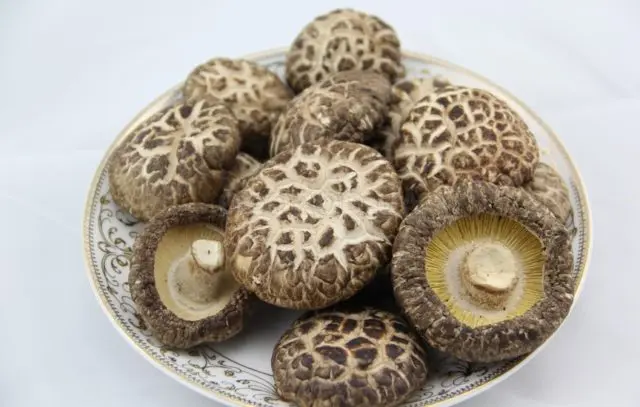
After the appearance of full-sized fruiting bodies, you can start harvesting. To keep the mushrooms longer, it is advisable to reduce the air humidity at the fruiting stage to 70%, and then to 50%. In total, there can be from 2 to 4 waves of mushroom ripening with an interval of 2-3 weeks.
How to grow shiitake mushrooms in your garden
It is quite possible to grow shiitake mushrooms in the country, but this can only be done in a suitable climate or artificially created microclimate. To do this, use bars of hardwood that do not have damage and rot. You can simply saw the trunks into segments 1-1,5 m long. The bars are laid horizontally on stands or goats. Then the mycelium is introduced. To do this, holes with a diameter of 2-3 mm are drilled in the bars to a depth of about 10 cm, grain or sawdust containing mycelium is quickly poured into them and immediately covered with wax or paraffin.
For further development of the mycelium, the bars are placed in any room in which the desired microclimate can be provided: temperature + 20-25 ° C and relative humidity of about 75-80%. Under the right conditions, the development of mycelium can take from six months to one and a half years. Usually there are 2-3 waves of shiitake mushroom harvest. Between them, it is recommended to cover the bars with a layer of special covering material that maintains optimal conditions for fruiting. In total, the active maturation of fruiting bodies can last from 2 to 6 years, while about 20% of the mass of wood is absorbed by fungi.

Shiitake Mushroom Harvesting Guidelines
Shiitake mushrooms are harvested when they reach the stage of technical ripeness. At this time, the hats had not yet taken a flat shape. 5-6 hours before the planned mushroom picking, the air humidity is reduced to 55-60%. Otherwise, the fruiting bodies will be watery, and bacterial brown spots may appear on the underside of the cap. A decrease in humidity contributes to the drying of the upper skin of the cap, which makes the mushrooms more transportable and resistant to mechanical damage.
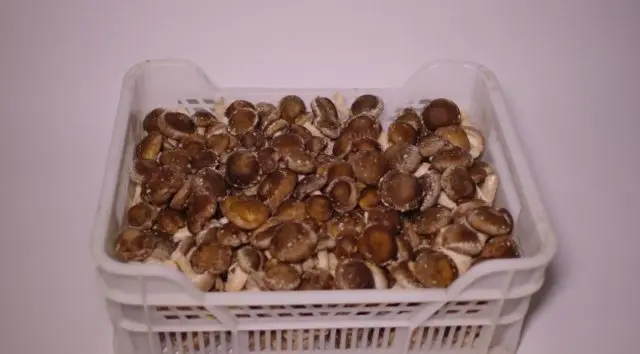
Mushroom caps are carefully cut with a sharp knife and placed in wooden boxes or baskets with a layer of no more than 15 cm. The crop is covered with plastic wrap to prevent drying out, and then sent to storage. Mushroom blocks are cleaned of remnants of the legs and particles of the fungus, otherwise mold may develop in these places.
An interesting video regarding the cultivation of shiitake at home can be viewed at the link:
Growing shiitake as a business
Growing shiitake mushrooms has long been a profitable business. Moreover, they are engaged not only in China and Japan, but also in many other countries. The main area of industrial production of shiitake is Southeast Asia. At the end of the last century, interest in growing these mushrooms in European countries increased significantly. Now the production of shiitake has been established in Germany, Austria, Italy, since the 70s of the XX century it has been grown in the USA and Australia.
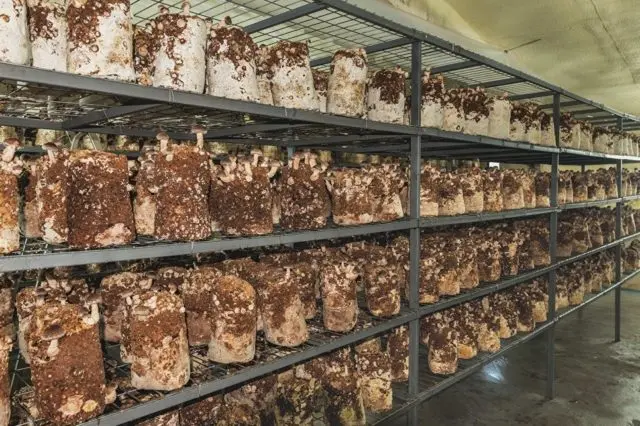
Since the beginning of this century, a noticeable interest in the industrial cultivation of shiitake began to manifest itself in Our Country. However, the rush demand for these mushrooms should not be expected. In many regions, residents traditionally prefer local wild mushrooms, the price of which is not comparable to the cost of shiitake. In stores, the price of these mushrooms can reach up to 1000-1500 rubles / kg, which is unacceptable for most segments of the population. Mushroom growers also prefer less labor-intensive and more popular oyster mushrooms and champignons, the demand for which is hundreds of times higher than for shiitake. Therefore, in Our Country, imperial mushrooms continue to be exotic.
Conclusion
Growing shiitake at home or in the country is possible, but it will require quite a significant investment. This is due to the need to provide a microclimate similar to natural growing conditions. In addition to this, the imperial mushroom is much more capricious and demanding than, for example, oyster mushroom. However, if you take into account all the subtleties and nuances, the result will be positive.










